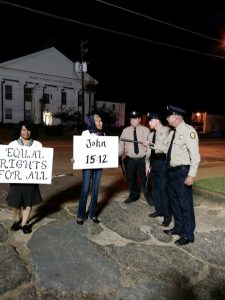
The Civil Rights Movement was an important era in American history and, more specifically, in Marion’s history. The town’s involvement in the movement is recognized in one tragic shooting of a local deacon, Jimmie Lee Jackson, when he was only 26 years of age.
On the night of September 9, the Courthouse square was lit up in a proud display. Twenty University of Alabama-Birmingham students of the Department of Theatre, as well as a handful of local Marion citizens, gathered around the square as they prepared to take part in a reenactment of the fateful night Jimmie Lee Jackson was gunned down.
Local resident Della Maynor, 67, was there to provide the Film School students with first-hand knowledge of the night of February 18, 1965. Maynor, who was 14 at the time, shared the events of that night such as what songs were sung, people in attendance, and what took place. What she recalled them sounds a little like this…
On the night of Jackson’s death, at least 500 Civil Rights activists had organized a rally to meet at Zion United Methodist Church in Marion. The rally itself was coordinated by C.T. Vivian, a Lieutenant to Martin Luther King Jr. The rally members had planned to march to the Perry County Jail, only a block away, where another civil rights activist, James Orange, was being held and protest Orange’s arrest. At the start of the rally, members attempted to kneel down to pray, but they were interrupted by local police officials, as well as Alabama State Troopers. The group members were instructed to call off the rally and return to their homes. According to Maynor, Reverend James Dobynes went against police officials wishes and instead knelt down to pray. Rally members were then attacked by Police, causing them to scatter in search of safety. An NBC reporter by the name of Richard Valeriani was also there in order to film the chaos. the After the lights of downtown Marion were cut off, leaving the night pitch black Valeriani and his filming crew turned on bright lights to aid visibility for filming. They
were immediately ordered by police officials to shut off their lights and cameras. Valeriani refused and was also attacked. They later learned that he ended up at a hospital in Birmingham for treatment. “I’ll never forget him.” Della Maynor stated.
Once rally members fled the scene, many went to a local establishment, named Mac’s Café, seeking refuge. “We thought it was a safe place, we went there,” Maynor said, “Still, they pursued us.” Resting in Mac’s Café were Jackson’s own mother, Viola Jackson, and his grandfather, Cager Lee. The police entered the café and attempted to force rally members to leave and return home. Upon hearing that his family members were in trouble, Jimmie Lee went to the cafe to defend them. Minutes later, he was shot by an Alabama State Trooper only a street away. Wounded, Jackson was sent to the hospital, where he passed away eight days later. Jackson’s tragic death later became inspiration for the Selma to Montgomery Marches of March 1965 and aided in the achievement of the Voting Rights Act of 1965.
The civil rights movement, while shaping both our country and our local community, has also helped shape the life of someone close to home. Dr. Billie Jean Young, Judson’s own Artist in Residence, credits the movement for shaping her life and furthermore, her creative processes. Originally from Choctaw County, Alabama, Dr. Young grew up unaware of the movement and its impact. Only upon meeting a Perry County resident did she learn about Jackson’s death and Marion’s own involvement. Dr. Young began to work with children at Francis Marion through Judson College. She asked them what interested them in theater. The students told Dr. Young of their desire to do something involving the civil rights movement.
“Although they had some stories, they weren’t talking about it. They had just heard that there was a movement here,” Dr. Young states. Dr. Young then began to invite people who were part of the civil rights movement who were still living, such as James Orange, to talk with her students. Upon hearing Orange’s story, more people were interviewed. “I was really bothered by the fact that we weren’t talking about Jimmie Lee,” says Dr. Young, “I had the research and I started to think about what I could do. Well, what I do – and that’s write a play!”
She began with Marion students, along with a handful of students from Uniontown, to do improvisations. Dr. Young then organized a listening session at Zion United Methodist Church open to anyone who wanted to talk about life during the civil rights era. “They didn’t have to be activists because it affected everybody. It’s all of our history because it happened here,” says Dr. Young. With all of this information gathered, Dr. Young was able to write the play, “JimmyLee”. The opening of the play was held at Lincoln School on the
day of Jackson’s death, February 26, and the play received a standing ovation. This play, for Dr. Young, was the first acknowledgement of what had happened that night.
“Somebody has to keep the history alive. The people were so appreciative, so proud that it made me realize that this was indeed important work. It was beyond creativity, it was soul enhancing!” said Dr. Young. “I tried through drama to at least make people think about becoming reconciled through our history and to each other.”